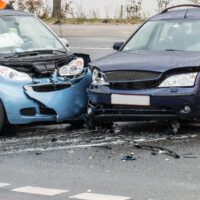Plaintiff Who Caused Crash Not Entitled to Recover for Personal Injury

Earlier this year, a judge in the New York County Supreme Court granted the defendant’s motion for summary judgment and dismissed the plaintiff’s personal injury lawsuit. The plaintiff’s own negligence was cited as the sole proximate cause of the auto accident which caused his injuries, and the judge did not think the plaintiff raised any serious question of fact about any comparative negligence on the defendant’s part to warrant a trial.
The car crash at the heart of the case in Gomez v. Yussuf occurred at the intersection of Rockaway Boulevard and Beach 56th Street in Queens. The drivers were in their left lanes and headed in opposite directions on Rockaway Boulevard. Both cars were already in the intersection when the plaintiff decided to execute a left turn without first stopping and waiting for a clear opportunity. There was no evidence that the plaintiff used his turn signal either.
It was clear that the plaintiff hit the defendant, because the damage showed that the front end and bumper of the plaintiff’s car impacted with the driver’s side of the defendant’s car. There was also no question that the plaintiff was negligent, since the defendant had the right-of-way under Vehicle and Traffic Law 1141 (driver turning left in an intersection must yield right of way to any vehicle approaching from the opposite direction and in or close to the intersection).
Nevertheless, the plaintiff argued that there was a question of fact regarding the defendant’s comparative negligence. Under New York law, an injured plaintiff can recover compensation for personal injury from a negligent defendant where both parties are at fault, even if the plaintiff is more at fault than the defendant. Any award of damages is reduced proportionately, however.
In this case, the plaintiff claimed the defendant should have seen him coming and was negligent in failing to stop, swerve or otherwise take steps to avoid the collision. The defendant did slam on the brakes, but it was too late to avoid the crash. The defendant claims she didn’t see the plaintiff until it was too late, but the plaintiff said he saw the defendant from half a block away, so she should have seen him coming.
Since the defendant was the one moving for summary judgment, she had the burden of establishing that the accident was not proximately caused by any negligence on her part. She did that by showing she had the right of way and did not see the defendant until it was too late. Under New York law, a driver with the right of way is entitled to expect that other drivers will obey the traffic laws. Also, a driver with the right of way who only has seconds to react to a vehicle which has failed to yield is not comparatively at fault for failing to avoid the collision.
The plaintiff’s argument failed because it was mere speculation that was not supported by any evidence that the defendant was negligent. For instance, the plaintiff did not show that the defendant was speeding or distracted, or that the defendant was not yet in the intersection when the plaintiff turned. The situation may have been different had the plaintiff been stopped and waiting to turn with a turn signal on, in which case he could argue that the defendant should have seen him and approached with caution.
